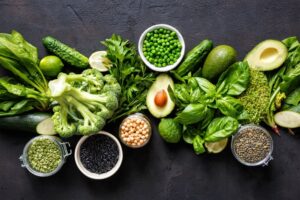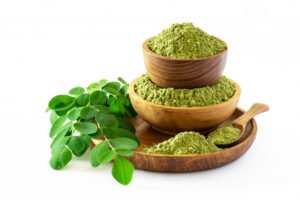A diabetes diet involves eating a balanced diet that is made of carbohydrates, fat, and protein in the right proportion.
If you have diabetes, your risk of having uncontrolled blood sugar and heart disease is pretty high.
This is why the National Institute of Diabetes, Digestive, and Kidney Diseases recommends following a healthy meal plan and being physically active to keep your blood sugar levels within the target range [1].
To help you stick to healthy food options, you should eat foods locally available in Nigeria.
Here is a list of the best foods for people living with either type 1, type 2, or gestational diabetes.
12 best foods for diabetics in Nigeria
1. Beans
Beans like black-eyed peas, bambara nuts, and soybeans are incredibly nutritious for diabetics.
They are rich in dietary fiber and protein that help satisfy the appetite and reduce cravings.
They also have a low glycemic index, which is important for managing and preventing diabetes.
Low glycemic index foods cause a slow rise in blood sugar, while high glycemic index foods cause a sharp rise in blood sugar and should be avoided in diabetes.
Beans are also versatile and contain iron, B-vitamins, magnesium, and potassium.
A study found that roasted soybean powder supplementation reduced fasting blood glucose and serum lipid levels in people with type 2 diabetes [2].
In another study, researchers found that beans contain complex carbohydrates that digest slowly and help regulate blood glucose and insulin after meals [3].
You can add roasted soybeans powder to your tea, pap, porridge, or stew.
2. Whole grains
Whole grains are rich in fiber and nutrients that keep you full and promote satiety.
They are high fiber foods and are great for diabetes because they are digested slowly – preventing a sharp rise in blood sugar levels.
Whole grains are also low glycemic index foods and are great for diabetics.
Examples of whole grains to include in your diabetes diet are:
- Brown rice
- Whole wheat
- Millet
- Sorghum (Guinea corn)
- Quinoa
- Bulgur
- Fonio (Acha)
3. African yam bean
The African yam bean is a legume that grows both tubers and seeds on the same plant.
The bean seeds and tubers are rich in fiber and resistant starch – making them a good carb option for a diabetes diet.
You can add the dried powder to your stew, soup, or pap, or eat them in a porridge.
Also read: African yam bean (Ijiriji): Nutrition, Benefits, and Uses
4. Green leafy vegetables
Vegetables are low in carbohydrates and rich in nutrients that help repair the body cells and prevent diabetes.
They are rich sources of fiber, vitamin C, folate, iron, potassium, magnesium, and antioxidants.
Antioxidants are substances that protect the body cells against damage by disease-causing free radicals.
Studies have found that the antioxidant properties of leafy vegetables may help people with diabetes [4].
Another study found that moringa leaves can help reduce blood sugar levels in diabetic patients [5].
Examples of leafy vegetables to include in your diet are:
- Pumpkin leaf (ugu)
- Jute leaf (ewedu)
- Moringa leaf
- Okra
- Cabbage
- Spinach
- Broccoli
- Scent leaf
- Bitter leaf
- Oha leaf
- Lettuce
- Amaranth
- Waterleaf
- Garden egg
You can add them to your soups, stews, salads, or porridge.
5. Fatty fish
Sardines, salmon, tuna, and mackerel are good examples of fatty fish that are rich in omega-3 fatty acids.
Omega-3 fatty acids contain DHA and EPA that help protect the heart and prevent the development of heart disease.
One study found that eating fatty fish may help regulate glucose levels in obese patients and prevent the development of type 2 diabetes [6].
You should eat fatty fish; roasted, grilled, baked, or boiled. Avoid frying.
6. Lean protein
For a balanced diabetes diet, your plate should consist of leafy green vegetables, protein, and carbs.
Lean protein is ideal for people with diabetes because they contain little fat.
Examples of lean protein to include in your diet are:
- Lean meat
- Goat meat
- Gizzard
- Catfish
- Tilapia
- Shrimp
- Chicken or turkey without the skin
- Meat substitutes, such as tofu
7. Nuts
Peanuts, walnuts, and cashews are incredibly healthy snacks for diabetics.
They contain lots of fiber, protein, and healthy fats that keep you full and prevent overeating. However, be careful of your portion size; as nuts are rich in fat.
Also, several studies have found that people who eat nuts have a lower incidence of heart disease, cancer, and diabetes [7].
You can eat nuts as a snack or sprinkle them as toppings on your yogurt or smoothies.
8. Low-fat milk or yogurt
For diabetics, low-fat dairy is ideal as it contains all the healthy nutrients in a low-calorie package.
You should opt for low-fat probiotic yogurt, as studies have found that the healthy bacteria (lactobacillus and bifidobacterium) found in them can help decrease bad cholesterol levels in type 2 diabetes people [8].
You can add milk or yogurt to your pap, pudding, fresh fruits, or smoothies. Always, make sure to choose the sugar-free varieties.
Also read: Akamu (Ogi): 10 Exciting Benefits for You and Baby
9. Fruits
Fruits are rich in fiber, vitamin C, folate, potassium, and antioxidants.
However, diabetics should practice portion control when consuming fruits because of their sugar content.
It is best to choose low-calorie fruits that are low in carbohydrates but high in fiber.
Examples of healthy fruits to include in your diabetes diet are:
- Avocado
- Lemon
- Orange
- Grape
- Strawberries
- Baobab
10. Cocoyam
Cocoyam also called taro is a good low glycemic index food for people with diabetes.
It is full of fiber and contains 12% of resistant starch – a special type of starch that humans cannot digest.
Its rich content of fiber and resistant starch helps to slow digestion and reduce blood sugar spikes after meals [9].
You can eat boiled cocoyam or eat them as fufu with any vegetable sauce of your choice.
11. Unripe plantain
Just like cocoyam, unripe plantains are rich in resistant starch that causes a gradual rise in blood sugar after meals.
Plantains are a rich source of fiber, vitamin C, potassium, and magnesium.
They are very versatile and can be eaten boiled, grilled, or as plantain fufu.
Also read: Unripe Plantain: Nutrition, Health Benefits, Recipes, and Side effects
12. Sweet potato
Sweet potatoes are rich in fiber and rank lower on the glycemic index scale than white potatoes.
This makes them a great carb option for people with diabetes, as they release their sugar slowly and do not cause a spike in blood sugar levels.
Also, they are great sources of vitamin A and C, potassium, and protein.
However, always practice portion control with sweet potatoes and take care not to overeat them.
You can enjoy sweet potatoes, boiled, baked, or grilled. For a balanced diabetes diet, add leafy veggies, and a source of lean protein.
Foods to avoid
One method to manage diabetes is by learning to differentiate between low glycemic index foods and high glycemic index foods.
Since high glycemic index foods cause a sharp spike in blood sugar levels after meals, it is best to reduce portion size or eat them with high fiber options, such as leafy vegetables.
Examples of high glycemic index foods include:
- Sugar and sugary foods
- White bread
- sugary soft drinks
- White potatoes
- White rice
- Pineapple
- Popcorn
- Melons
People with diabetes may also choose to limit the following foods and drinks:
Fried foods
Fried foods are high in saturated fat and trans fat. Both of which are linked to a higher risk of heart disease.
Foods like french fries, chips, and fried puff all contribute to weight gain that worsen diabetes.
Salty foods
Salty foods like processed meats are high in sodium, which may lead to high blood pressure and worsen diabetes symptoms.
Refined foods
Foods like breakfast cereals, cake, candy, biscuits, baked goods, and ice cream are high in added sugar which can impact blood sugar negatively.
Carb-heavy foods
Cassava fufu, garri, bread, pounded yam, semovita, tuwo shinkafa, etc. are examples of carbohydrate-heavy foods that should be limited.
They digest quickly and cause a sharp rise in blood sugar levels after meals; leaving you more hungry afterward.
If you must eat any carb-heavy food; make sure to combine it with lots of veggies and lean protein.
Sugar-sweetened beverages
Beverages with added sugars, such as fruit juice, soda, and sports or energy drinks, lack important nutrients but cause blood sugar levels to spike.
Drink water instead of sweetened beverages and consider using a sugar substitute (stevia, Truvia, etc.) in your coffee or tea.
Alcohol
Drinking alcohol in moderation may not have any serious side effects in people with diabetes.
However, if you’re on insulin shots or insulin secretagogues, alcohol may cause your blood sugar to drop too low – causing hypoglycemia.
The Centers for Disease Control and Prevention (CDC) recommend that women should limit alcohol to one drink per day, while men can have up to two drinks per day [10]
The bottom line
Incorporating these healthy foods into a balanced diabetes diet will help your body fight off many diseases, such as:
- High blood pressure
- High cholesterol
- Metabolic disorders
- Obesity
- Inflammation
Remember to be physically active by engaging in simple exercises like walking, swimming, and house chores.
- Diabetes, Eating, and Physical activity: www.niddk.nih.gov/health-information/diabetes/overview/diet-eating-physical-activity
- Chang, et al. (2008). Effects of soybean supplementation on blood glucose, plasma lipid levels, and erythrocyte antioxidant enzyme activity in type 2 diabetes mellitus patients. Nutrition research and practice https://doi.org/10.4162/nrp.2008.2.3.152
- Leathwood, P., & Pollet, P. (1988). Effects of slow-release carbohydrates in the form of bean flakes on the evolution of hunger and satiety in man. Appetite, 10(1), 1–11. https://doi.org/10.1016/s0195-6663(88)80028
- Tiwari, Ashok Kumar et al. (2013) Mitigation of starch and glucose-induced postprandial glycemic excursion in rats by antioxidant-rich green-leafy vegetables’ juice. https//doi:10.4103/0973-1296.117872
- Watanabe, S., Okoshi, H., Yamabe, S., & Shimada, M. (2021). Moringa oleifera Lam. in Diabetes Mellitus: A Systematic Review and Meta-Analysis. Molecules (Basel, Switzerland), https://doi.org/10.3390/molecules26123513
- Helland, A., et al. (2017). High intake of fatty fish, but not of lean fish, improved postprandial glucose regulation and increased the n-3 PUFA content in the leucocyte membrane in healthy overweight adults: a randomized trial. https://doi.org/10.1017/S0007114517001234
- Ley, S. H., Hamdy, O., Mohan, V., & Hu, F. B. (2014). Prevention and management of type 2 diabetes: dietary components and nutritional strategies. https://doi.org/10.1016/S0140-6736(14)60613-9
- Ejtahed, H. S., et al. (2011). Effect of probiotic yogurt containing Lactobacillus acidophilus and Bifidobacterium lactis on lipid profile in individuals with type 2 diabetes mellitus. https://doi.org/10.3168/jds.2010-4128
- Simsek, S., & Nehir El, S. (2015). In vitro starch digestibility, estimated glycemic index, and antioxidant potential of taro (Colocasia esculenta L. Schott) corm. https://doi.org/10.1016/j.foodchem.2014.07.052
- Lifestyle management: standard of diabetes care https://diabetesjournals.org/care/article/42/Supplement_Lifestyle-Management-Standards-of-Medical-Care
Get new free and exclusive health tips delivered straight to your inbox!



